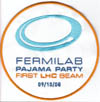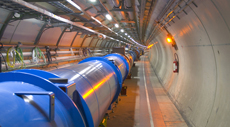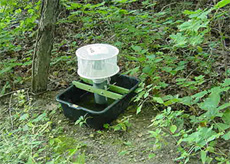|
Monday, Sept. 8
2:30 p.m.
Particle Astrophysics Seminar - Curia II
Speaker: B. Dingus, Los Alamos National Laboratory
Title: Surveying the TeV Gamma-Ray Sky with Milagro and HAWC
3:30 p.m.
DIRECTOR'S COFFEE BREAK - 2nd Flr X-Over
4 p.m.
All Experimenters' Meeting - Curia II
Special Topics: CMS Installation and Commissioning; Latest Results from the T-979 PSEC Experiment
Tuesday, Sept. 9
3:30 p.m.
DIRECTOR'S COFFEE BREAK - 2nd Flr X-Over
THERE WILL BE NO ACCELERATOR PHYSICS AND TECHNOLOGY
SEMINAR TODAY
Click here for NALCAL,
a weekly calendar with links to additional information. |
|
Monday, Sept. 8
- French Quarter gumbo
- French dip w/ horseradish cream sauce
- Smart cuisine: Santa Fe Pork Stew
- Smart cuisine: honey mustard chicken
- *Spicy hot Greek wrap
- Assorted sliced pizza
- Sweet n' sour Chicken w/ egg roll
*Carb restricted alternative
Wilson Hall Cafe Menu |
|
Wednesday, Sept. 10
Lunch
- Chile reno with a tomato sauce
- Rice & beans ~ pico de gallo
- Cold lime soufflé
Thursday, Sept. 11
Dinner
- Closed
Chez Leon Menu
Call x4598 to make your reservation. |
|
|
CERN reiterates safety of LHC on eve of first beam
A report published today in the peer reviewed Journal of Physics G: Nuclear and Particle Physics provides comprehensive evidence that safety fears about the Large Hadron Collider are unfounded. The LHC is CERN's new flagship research facility. As the world's highest energy particle accelerator, it is poised to provide new insights into the mysteries of our universe.
"The LHC will enable us to study in detail what nature is doing all around us," said CERN Director General Robert Aymar. "The LHC is safe, and any suggestion that it might present a risk is pure fiction."
Safety has been an integral part of the LHC project since its inception in 1994, and the project has been subject to numerous audits covering all aspects of safety and environmental impact. A comprehensive report by independent scientists addressing safety issues related to the production of new particles at the LHC was presented to CERN's governing body, the CERN Council, in 2003. It concluded that the LHC is safe. This report was updated and its conclusions strengthened in a new report incorporating recent experimental and observational data that was presented to theCouncil at its most recent meeting in June 2008. This new report confirms and strengthens the conclusion of the 2003 report that there is no basis for any concern about the safety of the LHC. The CERN Council is composed of representatives of the governments of the 20 European Member States of CERN.
Read more
|
Add a first LHC beam
patch to your pajamas
 |
| Iron-on patches for the LHC first beam Pajama Party |
Those registered to attend Wednesday's Pajama Party can get their LHC first beam patch this afternoon in the Office of Communication. Those who bring in their pajamas tomorrow can either pick up their patch or get their patch ironed on by Office of Communication staff.
|
Steps to the LHC startup

Magnets in the 27-km long tunnel. Image courtesy of CERN
Steps to starting up the LHC:
Cooling each of the machine's eight sectors to near absolute zero; electrical testing of 1,600 superconducting magnets; powering circuits of each sector; powering the eight independent sectors in unison; synchronization of the links in the accelerator chain; sending a bunch of particles partially around the ring in clockwise and then counter-clockwise beam tests; sending beam all the way around the ring both clockwise and counterclockwise; accelerating beam; making beams collide.
First beam:
On September 10, physicists at CERN plan to circulate a bunch of particles around the entire 17-mile LHC ring for the first time. Scientists will inject the particles at the energy of 0.45 TeV.
How much energy is a TeV?
Physicists use the unit electron volt to describe how much energy a particle has. An electron volt is the kinetic energy gained by a single, charged particle when it passes through an electrical field of one volt. One TeV equals 1 trillion electron volts, which equates to the acceleration provided by 1 trillion 1-volt batteries strung together. Watch this 4-minute video to learn more about electron volts and particle acceleration.
First collisions:
Later this year, physicists will accelerate the beams and make them collide. The plan is to accelerate beams both clockwise and counterclockwise to 5 TeV before the end of the year. The ultimate goal is to accelerate beams to 7 TeV. In comparison, the Tevatron accelerates each beam to 1 TeV.
|
Global computer network ready for Big Bang probe
From USA Today, Sept. 8, 2008
When scientists fire up the biggest physics experiment in history this week they will face a task that makes finding a needle in a haystack look simple.
Inside a 17-mile tunnel deep beneath the French-Swiss border they hope to detect evidence of extra dimensions, invisible "dark matter" and an elusive particle called the Higgs boson.
Success in this $10 billion endeavor would revolutionize our understanding of the universe.
But even the massive computing power at the European Organization for Nuclear Research can't sift through all the data that will pour in when its particle-smashing experiment begins on Wednesday.
So the Geneva-based lab, known by its old French acronym CERN, devised a way of sharing the burden among dozens of leading computing centers around the world.
The result is the "LHC Grid," a global network of 60,000 computers that will analyze what happens when protons are hurled at each other inside CERN's Large Hadron Collider.
"This is the next step after the Web," says David Colling, a scientist at Britain's Imperial College, which is contributing to the Grid. "Except that unlike the Web, you're sharing computing power and not files."
That computing power is needed if scientists are to find what they are looking for among the mountains of data produced when four giant detectors - 10 times more accurate than any previous instruments - begin measuring activity at the subatomic level.
"You can think of each experiment as a giant digital camera with around 150 million pixels taking snapshots 600 million times a second," explains CERN's Ian Bird, who leads the Grid project.
Read more
|
|
|
Vote and win
Since October 2007, people entering the Fermilab site have been greeted by safety messages. More than 40 messages have been on display so far. We want to hear which messages you think were the best - because they were useful, clever, funny or resonated with you for other reasons.
Please take a minute and vote for your five favorite safety messages here.
We will enter the names of all people participating in the vote in a drawing for prizes such as Fermilab baseball caps and fleece pullovers. Please vote by September 12. All employees, users and contractors of Fermilab and the DOE Fermi Site Office are invited to participate.
-- Kurt Riesselmann
|
Watch out for West Nile virus

Several traps located across the Fermilab site capture mosquitoes for testing.
Although we've experienced mosquitoes all season, the number of mosquitoes infected with West Nile virus typically increases in late summer and early fall. We recently recorded the first instance of a positive mosquito sample for the virus, so the danger of human exposure, while low, is present on site.
Last year, Kane and DuPage counties together recorded 23 human cases of infection. So far this year, Kane has recorded one case and DuPage has not had any. Only four human cases have been recorded in Illinois, none of which were serious.
Mosquitoes lay their eggs in standing water. To help reduce the number of mosquitoes that hatch, Fermilab's Roads and Grounds Department regularly applies a bacterial larvicide to storm water catch basins. When we begin to see large numbers of mosquitos in our traps, we spray an U.S. EPA-approved adulticide in select areas where there are frequent interactions between people and mosquitoes.
The best way to prevent your exposure to West Nile virus is to:
- Eliminate all sources of standing water that could breed mosquitoes, such as water in empty cans, tops of 55 gallon drums, old tires or any other receptacles.
- Avoid going outdoors when mosquitoes are most active, between dusk and dawn.
- Cover up. Wear socks, shoes, long pants and a long-sleeved shirt, preferably in a light color.
- Apply insect repellent that includes DEET according to label instructions.
- Repair or replace screens or block other routes for mosquitoes to get inside.
|
History Channel special program on LHC Tuesday
The History Channel will air a one-hour program on the Large Hadron Collider Tuesday, Sept. 9. The program titled "The Next Big Bang" airs at 7 p.m. CST, just hours before scientists start up the LHC.
The show will take viewers on an amazing journey through the 40 years of planning for the LHC, including how it was constructed and how it will work by smashing protons together at nearly the speed of light. The LHC consists of six large-scale physics experiments including the Compact Muon Solenoid, a large, general purpose detector. CMS involves the largest number of U.S. physicists, and has a remote operations center at Fermilab.
David Kaplan, a particle physicist and assistant professor in the Henry A. Rowland Department of Physics and Astronomy at Johns Hopkins University, will host the program.
|
|
Have a safe day!
Slow down on Pine Street
On Tuesday, Roads and Grounds will install a sign advertising the 25-mph
suggested speed limit for inbound and outbound traffic on Pine Street. The
suggested speed limit has been lowered to prevent accidents caused by
vehicles leaving the pavement and to promote safer driving through the
curves in the wooded area. For additional information, call Roads and
Grounds at x3303.
Megafloods lecture Sept. 12
Megafloods are the largest known freshwater floods with flows comparable in scale to ocean currents. They are capable of inducing global changes in climate. Fermilab Lecture Series will present a lecture on these floods by Dr. Victor Baker from the University of Arizona on Friday, Sept. 12, at 8 p.m. Tickets are $5. More information.
Mathematica 6 software in library
Wolfram's Mathematica 6 software is now loaded on one computer in the Fermilab Library on the 3rd floor of Wilson Hall. Anyone at Fermilab is welcome to use it. Please bring a thumb or flash drive if you would like to save your work. The library also has a circulating collection of books about Mathematica and a subscription to the journal Mathematica. Learn more.
Tuesday yoga class offered
Relax, take yoga. Yoga classes are offered from noon-1 p.m. Tuesdays in Ramsey Auditorium. The next eight-week session will run Sept. 9 - Oct. 28 and cost $80. For more information or to sign up, contact the Recreation Office at x5427 or e-mail kphelan@fnal.gov
Wilson Hall interior window washing
Wilson Hall interior window washing will begin on Monday and continue through Thursday. The schedule is below. Please clear all items from in front of windows prior to your floor's interior washing date.
Monday: Floors 12-15
Tuesday: Floors 8-11
Wednesday: Floors 4-7
Thursday: Ground, Mezzanine and floors 1-3.
Additional Activities |
|